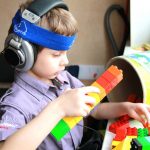Suzie was sitting next to her favorite teacher reading some passages of a story together. More often than not, her teacher interrupted her process requesting of her to reread a word. Suzie was becoming anxious. She knew that this was not without reason, something about what she sounded out was “wrong”. She really wanted to please her teacher, but she saw what she saw and heard what she heard in her mind’s ear. To help herself in the situation, she looked at the word again and took a guess she hoped was going to be the right one.
So many children and adults struggle to overcome the reading process. Reading is about the ability to use your senses in a coordinated manner to make use of symbols you see on paper. The technique for acquiring reading skill that is still mostly used in school systems is repetition at your own pace. If you repeat the same patterns long enough, you will only achieve the compensation your brain has to make in order to cope with the reading and not necessarily gain the ease of decoding that will lead to fluency.
In order to read a symbol, we have to first be able to see it. Suzie might be having difficulty with ocular scanning, or she might have difficulty appreciating the black and white contrast on the page (a form of visual hypersensitivity), or she might be seeing distorted images that are not stable to her and same symbols never quite look the same to her, to name a few. We do not know how Suzie uses her eyes in order to perceive the symbol. And she does not know to tell us because she assumes our vision would be the same as hers and we are seeing what she sees. The teacher does not know that no amount of repeating is going to change what Suzie sees unless she could find a way to use rote memory which will never gain reading fluency, not attract Suzie ever to pick up a book to read for pleasure.
When we insist on repetition of broken patterns of reading, we are only reinforcing what is not there, causing the very compensations we do not want to see.
It might be that Suzie can see the symbols quite well, but she has difficulty sounding out the word. The world of phonics is a large one and teachers do spend a great amount of time in early grades on phonics, which is truly a great work. The trouble is that you can only speak what you can hear. If Suzie is having difficulty assimilating sound in her inner ear, she might not be hearing the same sound that the teacher is pronouncing. Think of when we are trying to communicate in a foreign country and we are trying to pronounce the foreign language, but we simply cannot get the sound out. I think you get the idea, but this is what the world sounds like every day for a kid like Suzie. And once again, she has no idea that she is not listening in the same way to the same sound and therefore it is very hard to commit to memory and to use fluently. No amount of phonics repetition can replace that the auditory system does not perceive sound the same way as the sound projected.
But let’s say that Suzie can see and hear adequately. Keith Raynor’s research stated that good readers see about 11 to 18 character letters at a time and the phonics kicks in between 5 to 20 milliseconds later. We are talking split second timing now. If the visual and auditory system is not timed together, there is no way of gaining the fluency you need for reading.
Reading is complex, but it is also developmental. If we ignore the developmental aspect, we have to make too many assumptions that may simply not be true. When we insist on repetition of broken patterns of reading, we are only reinforcing what is not there, causing the very compensations we do not want to see.








